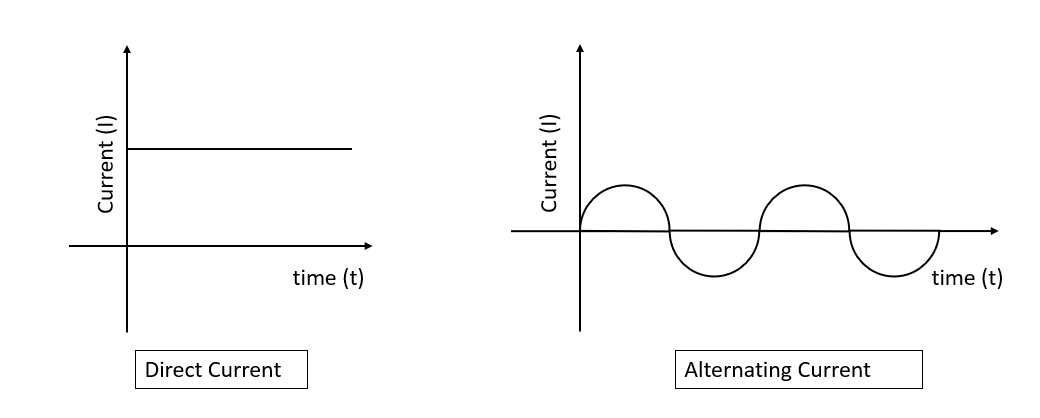
Graph of direct current and alternating current are-
Answer
501.3k+ views
Hint: Direct current (DC) is the transfer of electric charge in just one direction. It is the steady state of a fixed-voltage circuit. Most well-known uses, however, use a time-changing voltage source. An alternating current (AC) is the movement of an electric charge that is regularly in the opposite direction. If the source changes periodically, especially sinusoidally, the circuit is identified as an alternating current circuit.
Complete step-by-step solution:
Electric current moves in two ways: alternating current (AC) or direct current (DC). In alternating current, current keeps changing directions periodically – forth and backward. While in the DC, it runs in a single direction regularly. The main variation between AC and DC occupies the direction in which the electrons move. In DC, the electrons run steadily in one direction while electrons persist, switching directions, going forth, and then backward in AC.

The primary use of DC is to provide power for electrical appliances and also to charge batteries. Example: flashlights, mobile phone batteries, flat-screen television, and electronic vehicles.
Everything that operates on a battery and utilizes an AC adapter while using a USB wire for energy relies on DC.
Note: Most high-power distribution arrangements are AC. Moreover, the power is transferred at much greater voltages than the $120-V\ AC$. Economies of range make it affordable to make a few concrete electric power-generation plants than to create many small ones. This requires sending large power distances, and energy wastes in the path must be decreased. High voltages can be transferred with much fewer power losses than moderate voltages.
Complete step-by-step solution:
Electric current moves in two ways: alternating current (AC) or direct current (DC). In alternating current, current keeps changing directions periodically – forth and backward. While in the DC, it runs in a single direction regularly. The main variation between AC and DC occupies the direction in which the electrons move. In DC, the electrons run steadily in one direction while electrons persist, switching directions, going forth, and then backward in AC.

The primary use of DC is to provide power for electrical appliances and also to charge batteries. Example: flashlights, mobile phone batteries, flat-screen television, and electronic vehicles.
Everything that operates on a battery and utilizes an AC adapter while using a USB wire for energy relies on DC.
Note: Most high-power distribution arrangements are AC. Moreover, the power is transferred at much greater voltages than the $120-V\ AC$. Economies of range make it affordable to make a few concrete electric power-generation plants than to create many small ones. This requires sending large power distances, and energy wastes in the path must be decreased. High voltages can be transferred with much fewer power losses than moderate voltages.
Recently Updated Pages
A man running at a speed 5 ms is viewed in the side class 12 physics CBSE

The number of solutions in x in 02pi for which sqrt class 12 maths CBSE

State and explain Hardy Weinbergs Principle class 12 biology CBSE

Write any two methods of preparation of phenol Give class 12 chemistry CBSE

Which of the following statements is wrong a Amnion class 12 biology CBSE

Differentiate between action potential and resting class 12 biology CBSE

Trending doubts
What are the major means of transport Explain each class 12 social science CBSE

Which are the Top 10 Largest Countries of the World?

Draw a labelled sketch of the human eye class 12 physics CBSE

How much time does it take to bleed after eating p class 12 biology CBSE

Explain sex determination in humans with line diag class 12 biology CBSE

Explain sex determination in humans with the help of class 12 biology CBSE




